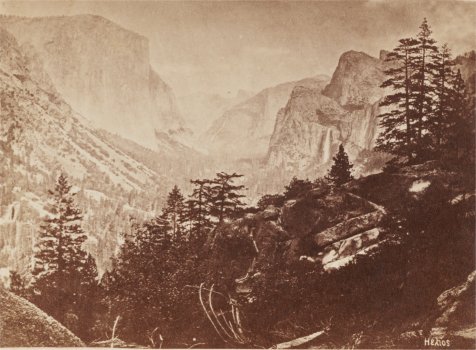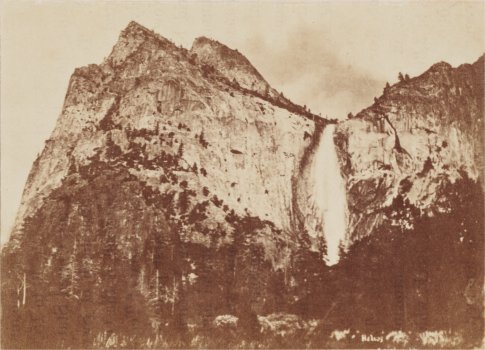
I. General View of the Yosemite Valley looking East from Komah,
(Moon Rock) on the Mariposa Trail, 1,500 feet above the Valley. The
prominent objects are El Capitan, the Half Dome, Cathedral
Rocks, and Bridal Veil Fall.
| Online Library: | Title | Author | California | Geology | History | Indians | Muir | Mountaineering | Nature | Management |
Yosemite > Library > Wonders & Beauties > Features >
Next: Best General View • Contents • Previous: List of Photographs
Yosemite Valley is generally regarded by travelers who have visited it, and have seen many of the most noted scenes in other countries, as one of the greatest, if not the greatest of the natural wonders of the world. Niagara, the Mammoth Cave, the Giant’s Causeway, the views from Mount Diablo, Mount Shasta, Mount Washington, Ben Lomond, or from any peak of the Alps, are rated as far inferior by those whose ability, taste and observation give authority to their judgment. There is more to see in Switzerland than in this one little valley, but if a fair comparison is to be made by taking into account the whole region of the Californian Alps, from the Mokolumne to Kern River, a distance of a hundred miles, the Helvetian Alps will be as much inferior as the Staubbach is to the grand Cataract of the Sierra Nevada is. The great attraction of Yosemite is the crowding of a multitude of romantic, peculiar and grand scenes within a very small space. One of these waterfalls, one of these vertical cliffs, half a mile high, one of these dome or egg-shaped mountains, or the chasm itself, as a geological curiosity, would be worthy of world-wide fame; but at Yosemite there are eight cataracts, five domes, a dozen cliffs, several lakes and caverns, and. numberless minor wonders, besides the big-tree groves near by, and a score of mountains that reach an elevation varying from 13,000 to 15,000 feet, including the highest peak of the United States, within sight. The cataract of the Staubbach, of Switzerland, reputed to be the highest waterfall of the Old World, is only nine hundred feet high, and that of Tequendama, in New Grenada, which had the first place in the New World before the discovery of the Yosemite, is only six hundred and fifty. The largest and highest works of human art dwindle into insignificance when compared in bulk or elevation with the tremendous precipices of Yosemite. The elevation of Cheops pyramid is four hundred and ninety-eight feet, and the highest cathedral spires are those of Strasburg, four hundred and sixty-six feet, Vienna, four hundred and forty-one feet, and of Rome, four hundred and thirty-two feet. They would be lost in the unnoticed talus of Tutucanula, which rises to 3,800 feet, or of Sentinel Rock, which ascends to 3,000.
Yosemite Valley is situated one hundred and forty miles east of San Francisco, on the western slope of the Sierra Nevadas, thirty miles west; of their summit, at an elevation of 4,060 feet above the sea. The general course of the valley is nearly east and west, its length about eight miles, and the width of the level

II. Pohono, (Spirit of the Evil Wind) Bridal Veil Fall, from the Northwest, a mile off; 940 feet high. |
The Merced runs nearly in the middle of tbe valley, is sixty feet wide, from three to eight feet deep in July, and the surface is generally from five to ten feet be- low the surface of the valley. The river is clear and the current lively; the descent in the eight miles of valley being about fifty feet. The water is never warm enough for comfortable bathing, but there are some ponds which get warm in the summer.
Prof. Whitney says:
“The peculiar features of the Yosemite are: first, the near approach to verticality of its walls; next, their great height, not only absolutely, but as compared with the width of the valley itself; and finally, the very small amount of debris or talus, at the bottom of these gigantic cliffs. These are the great characteristics of the valley throughout its whole length; but, besides these, there are many other striking peculiarities and features, both of sublimity and beauty, which can hardly be surpassed, if equalled, by those of any other mountain scenery in the world.”
Horace Greeley, in his Overland Journey to California, says: “The Yosemite Valley (or gorge) is the most unique and majestic of nature’s marvels.”
In a letter published in the New York Independent, in March, 1868, he wrote thus:
“Of the grand sights I have enjoyed—Rome from the dome of St. Peter’s—the Alps from the valley of Lkae Como—Mont Blanc and her glaciers from Chamouny—Niagara—and the Yosemite—I judge the last-named the most unique and stupendous. It is a partially-wooded gorge, one hundred to three hundred rods wide, and 3,000 to 4,000 feet deep, between almost perpendicular walls of gray granite, and here and there a dark yellow pine rooted in a crevice of either wall, and clinging with desperate tenacity to its dizzy elevation. The isolation of the Yosemite—the absolute wilderness of its sylvan solitudes, many miles from human settlement or cultivation—its cascade 2,000 feet high, though the stream which makes this leap has worn a channel in the hard bed-rock to a depth of 1,000 feet—renders it the grandest marvel that ever met my gaze. Next to Yosemite, I judge that Niagara has more distinct and diverse attributes of sublimity than any other.”
The opinion of Starr King was that:
“Nowhere among the Alps, in no pass of the Andes, and in no cañon of the mighty Oregon range, is there such stupendous rock scenery as the traveler now lifts his eyes to.”
The following is in extract from Bowles:
“ Indeed, it is not too much to say that no so limited space in all the known world offers such majestic and impressive beauty. Niagara, alone, divides honors with it in America. Only the whole of Switzerland can surpass it—no one scene in all the Alps can match this, before me now, in the things that mark the memory and impress all the senses for beauty and for sublimity.”
Richardson wrote thus:
“ The measureless, inclosing walls, with these leading towers and many other turrets; gray, brown and white rock, darkly veined from summit to base with streaks and ribbons of falling water; hills, almost upright, yet studded with tenacious firs and cedars; and the deep-down level floor of grass, with its thread of river and pigmy trees, all burst upon me at once. Nature had lifted her curtain to reveal the vast and the infinite. It elicited no adjectives, no exclamations. With bewildering sense of divine power and human littleness, I could only gaze in silence till the view strained my brain and pained my eyes, compelling me to turn away and rest from its oppressive magnitude.”
Having considered thus the general features of the valley, let us take up the principal peaks, cliffs and falls, one by one.
Next: Best General View • Contents • Previous: List of Photographs
| Online Library: | Title | Author | California | Geology | History | Indians | Muir | Mountaineering | Nature | Management |
http://www.yosemite.ca.us/library/yosemite_its_wonders_and_its_beauties/general_features.html